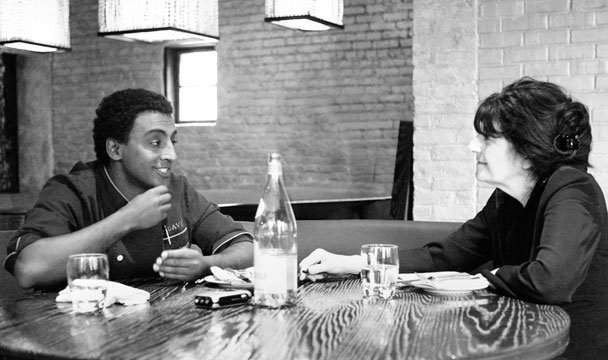Superstar chef Marcus Samuelsson is tackling African cuisine in a big way. His new restaurant, Merkato, opens today, with an ambitious menu of traditional and reimagined dishes from across the vast continent. Editor in Chief Ruth Reichl visited him at Merkato for a first taste, and spoke to him about the challenge of introducing an entire new palate to American diners; the concept of taste memory; and the prevalence of culinary racism.
Q. Let’s talk a little about why you decided you wanted to do this restaurant.
A. I don’t think I had an option not to do it. I had to do it to satisfy the creativity within me. I think it started for me more than 10 years ago; [in Sweden,] all fine dining restaurants were French. It was Swedish food certainly, and we had Swedish ingredients, but it was filtered through French service, French wine, and French etiquette.
And then I came to America and saw that it doesn’t just have to be French. I started seeing American chefs doing Japanese cuisine and all of these different things, and I just said, “Why couldn’t it be African?” I don’t think I would have been able to see that if I hadn’t seen all these cultures and possibilities in America.
And certainly going [to Ethiopia] with Gourmet and having a chance to see more food, that was the starting point. I didn’t know enough about Africa, and I had to know more.
Q. I know that there’s not another restaurant like this in the United States. Is there anything in Europe?
A. Not one like this, I think. There’s Momo in London, which has a Northern African theme—Tunisia and Algeria and so on.
Q. And that’s the most familiar.
A. Absolutely. [Momo is] only looking at that region. Then there are some South African restaurants in Cape Town that have a similar sort of high-end approach, but they’re only looking at Malay cuisine and the Malay story of South African cooking. We are really looking at the whole of Africa, where Africa took influences from, and also what Africa influenced, like Brazil, like the Southern states of America. We can’t just do it in the 40 dishes or 50 dishes we have now, but in two years, three years, four years, that’s when people will see the broader map of Africa and what’s possible. That’s why we have things that cost $4 on the menu—the cheapest little street foods—and things like lobster that are very lush.
Q. It’s a very big task you’ve given yourself; you’re really trying to introduce an entire new cuisine. In your book, you divided the continent into quarters. Which quarter is closest to your heart?
A. Ethiopia because of my family. Every time I eat an Ethiopian meal I think about them. My reference point is my stepmother in Ethiopia and the way she makes berbere: This is how it has to taste, and the injera has to be a certain way. Like any good cook, she’s an elitist and a good editor. I think about all that when I eat Ethiopian food.
And I have to say that the palate that I’m very excited to introduce is South African Malay cooking, because I think it’s a palate that Americans will love. It’s not spicy food, but it’s flavorful food. Through trading, the Indonesian Malay was infused with the Dutch, infused with the black South African. There are tones of Indian [cuisine] in there, so Americans are familiar with it. And there are tones of Southeast Asia—like sambal and so on. I think that is a surprise, that there is so much Asian cooking in Africa.
We’re also doing what we call the kidogo bar. Kidogo is a Swahili word meaning “small bites.” It’s sort of street food from throughout Africa: There will be some falafel, there will be sambals, chutneys, different kinds of breads, olives from the North, accara from the South. Hummuses, olives that we marinate, pickled peppers; we go from spicy cucumbers to lighter sorts of chutneys, and we have tripe. And here we have shrimp accara from the…
Q. I’ve only had those from the Caribbean.
A. And Caribbean food is completely West African–influenced, from Haiti and Nigeria. Like all food, whether you’re talking about Persian food, or Chinese food, or Swedish food, it’s always a reflection of wars, trading, a bunch of good and a bunch of bad. But what’s left is always the food story. We know so much about the European food story, and we’re getting to know about the American food story; but we know so little about the African food story.



 Pinterest
Pinterest


